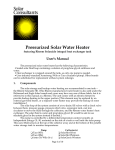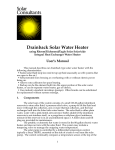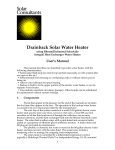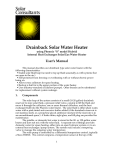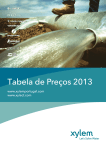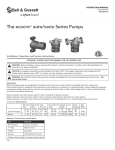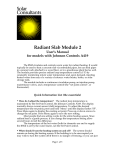Download Rheem 619 User`s manual
Transcript
PV Pressurized Solar Water Heater
featuring Rheem Solaraide integral heat exchanger tank, and a
photovoltaic-powered circulator
User's Manual
The pressurized solar water heater has the following characteristics:
• Sealed solar fluid loop containing a solution of propylene glycol antifreeze
and water.
• Heat exchanger is wrapped around the tank, so only one pump is needed.
• 12V DC circulator (pump) matched to a photovoltaic (PV) panel provides
water heating even during AC electricity outage.
1.
Components
The solar storage and backup water heating can be accommodated in one
tank -- the Rheem Solaraide HE. (This Rheem-manufactured water heater is also
sold under the Richmond and Eagle Solar brands and yours may have any one
of those labels, but it is referred to in this manual as a Rheem.) The unit comes
with an electric element to provide backup heating to the upper portion. [This
element may be replaced by an external gas-fired heater, or a separate water
heater may provide the backup in some installations.]
The solar loop of the system consists of a two drain/fill valves with a
check valve between them, pressure gauge, pressure relief valve, expansion
tank, 12 V DC circulator (typically a March 809 or Laing bronze pump) to move
the fluid through the collectors and the Rheem water heater's heat exchanger.
The solar fluid is water and propylene glycol. [It would be safe to use ethylene
glycol in the system instead if desired.]
Pump
❏ Laing D2 (w/ capacitor)
❏ Laing D5
❏ March 809
❏ ________________
1
Collector(s)
❏ SolarHot Silver
❏ SolarHot Platinum
❏ SolarGenix Winston
❏ AET
2.
Description of Operation
The pump is controlled by the current generated by the PV panel. In
strong sunshine, when the collectors are absorbing lots of heat and the PV panel
is generating its peak current, the pump runs fast. At times of lesser sunshine,
the pump runs proportionally slower.
The solar fluid circulates through the collectors and the heat exchanger,
thereby warming the water in the lower half of the tank. As it warms, this water
rises into the upper half until all the tank is heated. On a day with intense
mottling of clouds and sun it is possible for the pump to stop and start several
times.
2
By the end of a sunny day when little domestic hot water had been used
the water could easily reach 130 to 150°.
At times when solar heating has not brought the top of the tank to full
temperature, the backup heating thermostat will turn on the electric element or
gas burner. This thermostat is behind the access panel on the water heater. [The
diagram above shows the electric element as a backup. Your system may use a
separate burner or tank as backup.]
3.
Installation
This section is intended to inform the system owner of some of the
considerations and logic that went into the installation of solar equipment. It may
be helpful if a re-roofing, renovation, or other change demands part of the
system be moved.
Collectors and Pipes
Your collectors may have been mounted using any of several methods,
depending on whether the feet are attached directly to the collector frames or a
separate aluminum frame was fabricated to hold the collectors, whether they are
parallel with the roof surface or held up with legs, etc. In all cases each foot has a
stainless steel lag bolt that penetrates the roof into solid wood (except for
standing seam roofs, where a clamp may be used to avoid penetration), and each
is sealed with a long-lasting roofing sealant.
The ideal mount faces the collector array south at approximately a 45°
angle from horizontal, although the performance will not suffer greatly if they
do not face due south or attain a 45° angle.
If the collectors must be moved for roof repairs consult a solar installation
professional beforehand to ensure the system is shut down and drained properly
and the collectors are handled properly.
4.
Maintenance
The antifreeze in the solar fluid should be tested and, if needed, replaced
every five years.
Your water heater includes an anode rod that protects it from corrosion
from the potable water. It also should be checked at least every five years. If the
electric element is wired up, turn off the electric element's 240V (double) circuit
breaker or pull the disconnect before draining any water or unscrewing the
anode. To check the rod, turn off the cold water inlet and drain off the hot water
pressure down to the level of the top of the tank, then unscrew the sacrificial
anode rod -- it is the large hex-head in the top of the storage tank (water heater)
-- and pull it up to examine the rod. If it is deeply pitted or more than six inches
of core wire is exposed at either end of the rod, replace it. After the anode is back
in place and the cold-water valve is back on, open several hot water taps long
enough to blow air out of the tank and lines before restoring electric power to
the element.
March pumps' brushes should also be checked every five years. Laing
pumps do not have brushes and require no maintenance.
The pump impeller is lubricated by the fluid it pumps and requires no
maintenance, but if it ever sits a month or so without running the fluid can leave
3
deposits that will prevent it being able to start without being taken apart and
freed up.
Some older March brand pump motors require a few drops of oil -usually 20W, sewing machine, or light-duty motor oil -- every six months. Laing
and newer March pumps use ball bearings and require no oil. Look for holes
with small black tubes at the motor ends (marked "OIL") to see if your pump
should be oiled. It may also be marked on the name plate, or call the pump
manufacturer for details.
If the system must be left not operating for more than a few days,
especially in hot weather, drain the glycol into a clean bucket and unplug the
control. Most systems contain about five gallons of glycol.
Outdoor pipe insulation and caulk should be checked annually. Insulation
can be damaged by animals, branches, and ultraviolet rays. If the insulation is
not protected by a jacket it should be repainted with an exterior paint. All joints
in insulation should be sealed. Pay special attention to sealing where insulation
meets the collector or roof flashing. Also check the wire connection to the PV
panel. Some panels have a permanently attached cable; others have connection
boxes. If there is a box, check its integrity and seal with silicone to keep water
out. Examine the cable jacket anywhere it is exposed. This should be protected
from sunlight insofar as is possible.
Indoor pipe insulation should be checked every few years. Patch any
areas where shrinkage or damage has caused gaps to form, using insulation
rated for high temperatures (rubber foam, isocyanurate foam, or fiberglass; not
plastic foam.)
Animals – indoor cats in particular – are attracted to the warmth of the
system. The top of a tank makes a great place to sleep. You may have to wrap
screen wire around insulation to keep them from tearing it. Most solar heating
systems use propylene glycol antifreeze, which is not harmful to drink -- at least
when it is new. But if your system contains ethylene glycol antifreeze instead of
propylene, no pets should be allowed access to the pump area, in case of a
release or leak of fluid.
5.
Shut-Down
If you plan to be away from home or for some other reason no hot
water will be used for days at a time, you may want to turn off the power to the
backup heating element and turn off the well pump or close the whole house
water supply valve, or at least close the hot water shut-off valve. Shutting down
the water supply is good insurance against a water leak anywhere in the house,
having nothing specifically to do with solar heating. If no hot water is being
used it is possible for the solar loop to overheat. For safety the system includes
two pressure relief valves, which open if pressure builds too high from
overheating. The one on the top of the water heater can discharge a good deal of
water, while the one on the solar loop can discharge a small amount of antifreeze
into the drain pan. The best way to avoid this inconvenience is to cover the
collector(s) with a tarp, but do not cover or shade the PV panel.
Should maintenance be required for the hot water tank or hot water
pipes, turn off the double (220V) circuit breaker serving the water heater before
draining the water. This is to protect the backup electric element from damage.
After water pressure is restored and the tank is full, purge air from the potable
lines before restoring electricity. PV-supplied electricity to the solar pump should
be left connected even if the water tank is drained, so long as the solar fluid lines
4
are not disturbed. This allows the system to relieve some of its heat into the heat
exchanger.
If for any reason the solar loop is taken out of service, i.e., the pump will
not be running or the pipes will be cut for renovations, the glycol should be
drained into a clean bucket and the collectors flushed thoroughly with water.
6.
Troubleshooting
If you are ever uncertain of whether the sun is heating your water or not,
try turning off the backup by switching off the water heater element 220V
breaker or the pump to the gas backup. Be sure that DC power is still connected
to the solar pump. Leave it this way for at least a day. You should continue to
have hot water as long as there is a reasonable amount of sunshine and you are
not using more hot water than the system was designed to supply. To enjoy the
greatest economy, leave the backup switched off through the summer.
The best basis for troubleshooting is to become familiar with the sounds
the system makes in normal operation. Also, by feeling the pipes on a sunny
morning you should be able to tell a difference in the temperature of the fluid
going up to the collectors and that returning. The return fluid should be warmer,
although the temperature difference may be slight. But be careful: these pipes
can be scalding hot!
Another troubleshooting tool is the pressure gauge. Most systems will
run with as little as five pounds of fluid pressure, but were probably charged
with fifteen to thirty when installed. There may be a mark on the gauge or a
note written on the tank showing the original pressure. If the pressure has fallen
it may be due to a pressure blowoff from overheating, a dripping drain/fill
valve, a punctured expansion tank, or a leak at some other fitting or in the
collectors. If the pressure is low when cold but high when hot it indicates air in
the lines or a faulty expansion tank. (See next paragraph.) If the gauge is near the
pump by disconnecting and reconnecting the 12VDC wire you may be able to
see a slight change in pressure (2-4 p.s.i.) as the pump turns off and on. This is a
good indication that the solar pump is circulating fluid. {Under any condition
other than bright sunshine you will need a 12V power supply to test the pump
this way.]
Pressurized systems are normally very quiet; the pump hums softly, the
fluid runs smoothly. A gurgling sound from the pipes or a “popcorn popping”
sound from the pump indicates air in the lines. This should be corrected
immediately, as air, antifreeze, and heat combine to form corrosive organic acids
that can corrode your collectors.
The pump body normally runs warm to the touch. It should never
become so hot as to discolor or blister the paint, however. If the system does not
seem to be circulating heat down from the collectors and the pump is hot (and
possibly humming) and especially if it fails the pressure change test mentioned
above, call a solar repairman. You may need to drain off some solar fluid or
cover the collectors to prevent overheating until the pump is repaired.
The solar heating system is functionally independent of the backup water
heating or space heating systems.
5
Symptom:
1) Pump never runs.
2) Pump hums and/or
gets warm but does not
circulate fluid.
3) Noises
Likely Causes:
1a) Check for voltage from PV panel while sun is on
the collectors. If none is present, check at PV panel to
determine if the fault is in the panel, the junction box,
or in the wire.
1b) If voltage is present at pump, try substituting a
20W 12V DC power supply. If that starts pump
running, some change has caused the PV to be
insufficient to run the pump. If the substitution does
not start the pump, then the pump should be
replaced. March pump may need brushes replaced;
Laing pumps have no brushes.
2a) Pump’s impeller (rotor) may be stuck. The solar
fluid will have to be drained to open and free up the
impeller, so this is best left to a solar repairman.
2b) Fluid pressure may be too low for circulation.
Check gauge and call us with reading.
3a) The pump is lubricated by the water it pumps.
The noise should be a steady hum or whine, varying
with the intensity of sunshine. Pinging or a soft
“popcorn popping” indicates air in the lines.
3b) Screeching or clattering indicates pump bearings
are shot; disconnect one of the two wires from PV
and cap off the exposed conductors. Drain the glycol
from the solar loop into a clean five gallon bucket.
Call a repairman. Do not let this situation go
unrepaired.
6
4) Water not hot enough
7.
Determine the events that cause this. Is it true all the
time (in which case the tempering (mixing) valve, if
installed, is suspect), only when there has not been
much sunshine (in which case the backup heating is
not sufficient), or only when you turn off the backup
(in which case the solar may not be fully
functioning)?
If the problem seems to be the backup heat and
this is provided by the electric element in the upper
portion of the solar tank, the tank's overtemperature
protection switch may have cut off. Shut off the 240V
circuit breaker or disconnect to the water heater,
open the access panel and locate the red button at the
upper end of the thermostat. Push the red button
and feel for a distinct click. If you feel that click, then
you have reset the overtemperature protection.
Reattach the cover and restore electricity to the
element. After twenty minutes you should have hot
water as usual. If that was the problem then most
likely the solar was providing more hot water than
you were using. On good solar days, that is, on days
when your water heating is free and uses no outside
electricity, you can use warm or hot water for things
for which you normally use cold.
It is also possible you have begun using more hot
water than your system was designed to provide.
Notes Regarding Parts
• solar fluid pump: model 809-BR-12 , March Manufacturing, Glenview, IL or
Laing Ecocirc, Laing Thermotech, Inc., 2295 Main Street, San Diego, CA 92154,
phone (619) 575-7466.
• photovoltaic panel: any brand may be used. Nominal 20 Watt peak output for
March pump; 10-15W for Laing.
• collector(s) typically SolarHot Gold, Platinum (Morrisville, NC) Winston Series
CPC collector: (Solargenix Energy, Chicago IL) or AE series (Alternate Energy
Technologies, Jacksonville. FL).
• All other parts are standard items obtainable from local plumbing supplier. If
you are replacing any parts, especially the expansion tank, make certain the new
part is rated for fluid temperatures >180°F.
8.
Specifications
Electrical requirements: none for solar; standard backup heater element is 4500
Watt, but 6000 Watt or other size may have been installed.
Options:
• TD-6 Remote Temperature Display with six temperature readings, storage of
minima and maxima.
Design changes and part substitutions may be incorporated in custom or
future systems.
7
9.
Warranty
Parts and workmanship for a complete system installed and maintained
by Solar Consultants are warranted by Solar Consultants for one year from the
installation date. Individual parts, especially tanks, pumps, collectors, and
controls, may be covered by additional manufacturers’ warranties. Solar
Consultants expands those warranties to include labor for replacement of
manufacturer warranted parts.
Solar Consultants warranty is void if the system has been allowed to run
without fluid(s) or has been allowed to remain in a non-operating condition for
more than thirty days.
Solar Consultants is not responsible for damage attributable to domestic
water chemistry, including but not limited to hardness, acidity, or chloramines
content.
Manufacturers' Warranties (subject to change without notice)
March pumps (March Maufacturing, Inc., 1819 Pickwick Ave., Glenview,
IL 708-729-5300) are warranted for one year from date of installation and Laing
pumps for two. (Laing Thermotech, Inc., 2295 Main Street, San Diego, CA 92154,
phone (619) 575-7466).
Rheem/Richmond/Eagle Solar water heaters have six-year warranties.
Most brands of collectors carry a ten-year manufacturer's warranty
against defects or leakage, but not against damage from freezing or outside
forces. (Homeowner's insurance covers limb and storm damage.) Solar
Consultants' used collectors are warranted for five years against defects or
leakage.
Solar Consultants
P.O. Box 1254
Carrboro, NC 27510
919-831-5304
© 1994 Solar Consultants , revised 9/12/2009 TW
8
Glossary
Ball Valve an in-line valve that controls fluid flow. They are preferable to other
types in that they do not restrict flow when open and never need a washer or
seal replacement.
Check Valve an in-line valve that allows fluid to pass in only one direction.
Expansion Tank a small tank containing an air-filled bladder surrounded by
fluid. As the fluid expands it compresses the air. This evens out pressure
fluctuations that would be caused by temperature change.
Key Vent a bleed valve used to purge air from a pipe. It is opened with a
screwdriver or square key similar to a skate key.
Pressure Relief Valve a safety valve which opens to dump fluid or water if the
pressure goes beyond its set point. Sometimes the set point is adjustable; on
solar loops it may be set from 30 to 125 p.s.i. On a standard water heater the PRV
is combined with a temperature probe so that it can open if either pressure or
temperature exceed safe limits. The outlet of the valve is sometimes piped to the
drain pan, the crawl space, or outdoors.
Solar fluid The fluid consists mostly of water, mixed with an anti-corrosive
buffer, propylene glycol, or ethylene glycol.
Solar loop the portion of the system that carries the fluid that passes through
the collectors to be heated by the sun. This fluid is (in our systems) kept
completely separate from the domestic water. Heat passes from the solar fluid
to the domestic water in the heat exchanger.
Tempering Valve an automatic thermostat mounted at the hot water outlet of a
water heater. If the outgoing water is above its set temperature, the valve allows
cold water to mix in.
© 1994 Solar Consultants , revised 8/4/2009 TW
9









